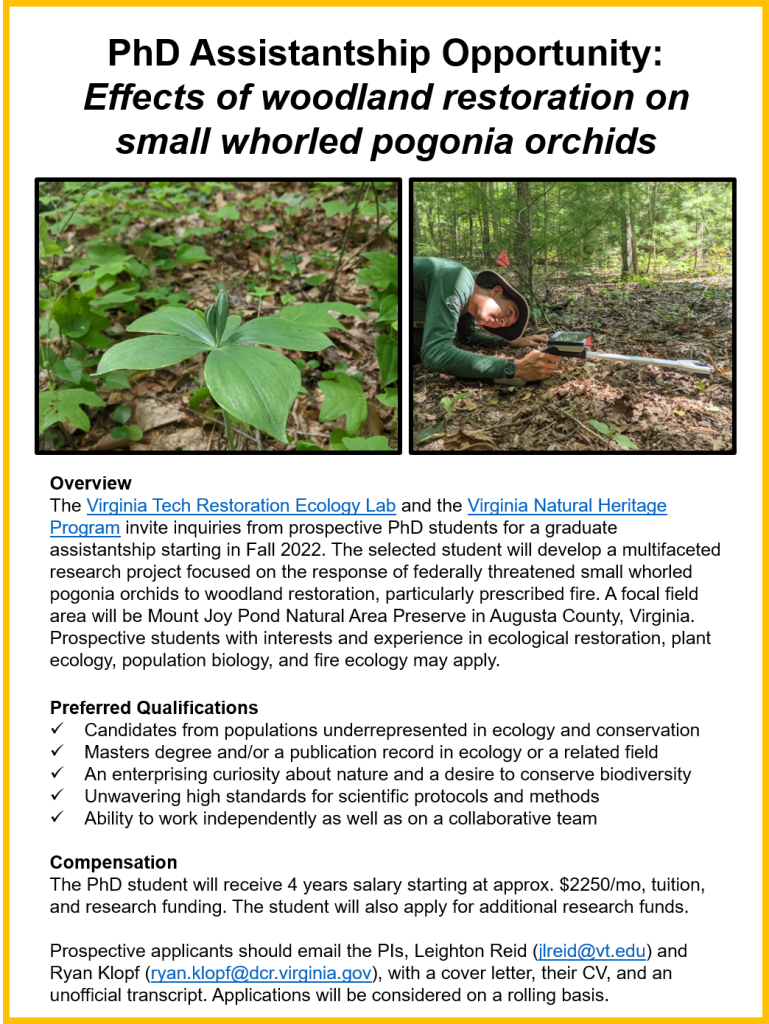By Leighton Reid and Ryan Klopf
Leighton Reid is an assistant professor of ecological restoration in the School of Plant and Environmental Sciences at Virginia Tech. Ryan Klopf is the Mountain Region supervisor and natural areas science coordinator for the Virginia Natural Heritage Program. They describe a new research project that aims to understand how an important restoration tool impacts the population dynamics of federally threatened small whorled pogonia orchids. This project has an open PhD position available to start in January 2023; details can be found at the end of this post.
Deep in the heart of Virginia’s Shenandoah Valley, nestled against the western edge of the Blue Ridge Mountains, two clusters of small, green orchids grow in the dappled sunlight of a woodland understory. The orchids are small whorled pogonias (Isotria medeoloides) – a rare species that is considered threatened by the United States government because its population is declining so quickly that it could become endangered in the foreseeable future. We have monitored these populations for the past two summers, keeping tabs on every individual, to learn how this species is affected by one of the most important restoration tools in North America – prescribed fire.
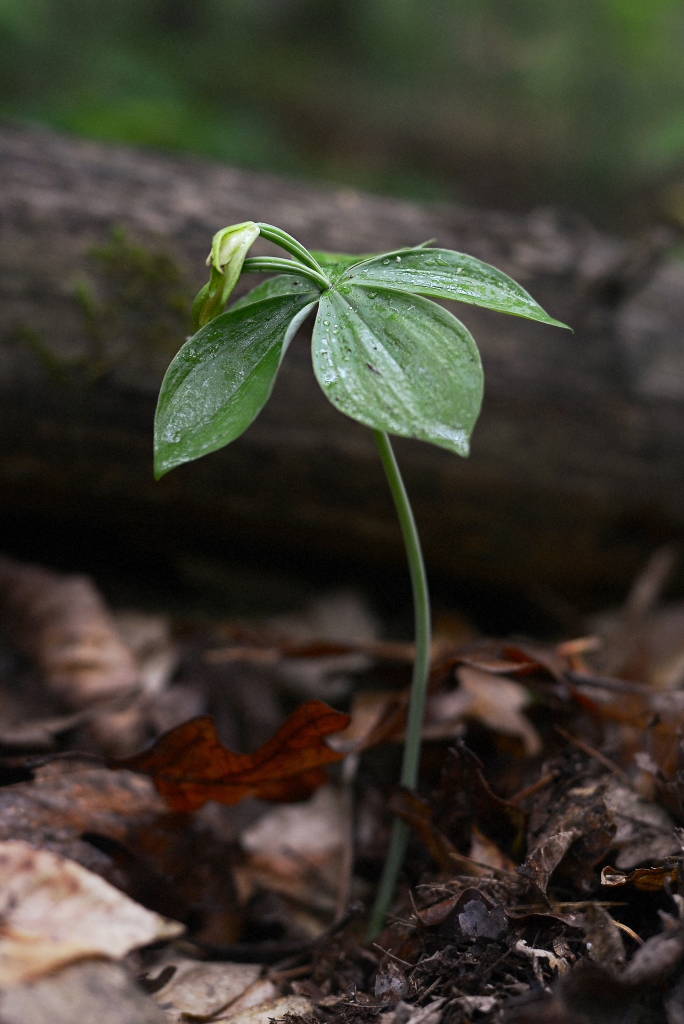
Small whorled pogonia
As their name implies, small whorled pogonias are small (≤25 cm) and whorled (their leaves radiate outward from the stem). This species is a member of the Pogonieae, an orchid tribe that includes species in Asia and eastern North America. Its closest relative is the large whorled pogonia (I. verticillata) which sometimes grows alongside small whorled pogonia, but is distinguished by its purplish stem (small whorled pogonia has a whitish green, glaucous stem).
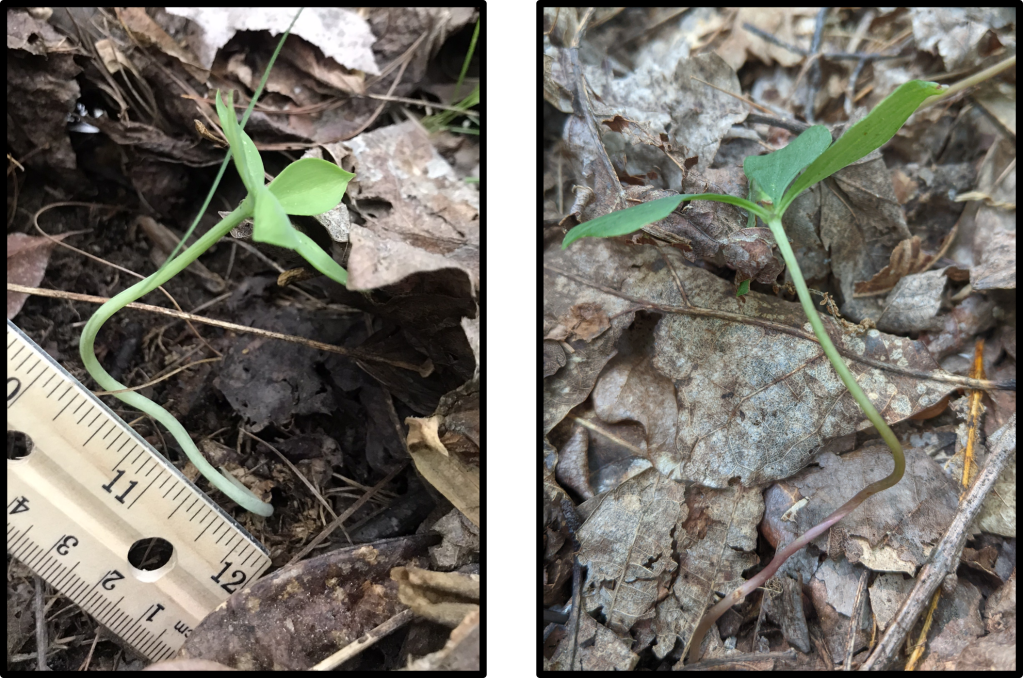
Small whorled pogonias emerge from the leaf litter in late spring and in some years produce one or two solitary greenish yellow flowers, particularly when plants are exposed to more sunlight. Their flowers do not require any help with pollination; they produce the same amount of seed whether they are cross-pollinated or pollinate themselves.
The seeds themselves are tiny – like vanilla seeds, which are in the same orchid sub-family (Vanilloideae). The parent plant (which is usually both a mother and a father) provides almost no resources at all to its offspring. Each seed’s fate is closely linked to whether or not it finds a mycorrhizal fungus in the Russulaceae family to help it acquire the resources that it needs to survive and grow. In a typical relationship between plants and mycorrhizal fungus, the fungus scours the soil for nutrients like nitrogen and phosphorus and provides them to the plant in return for energy in the form of carbohydrates, which the plant produces through photosynthesis.
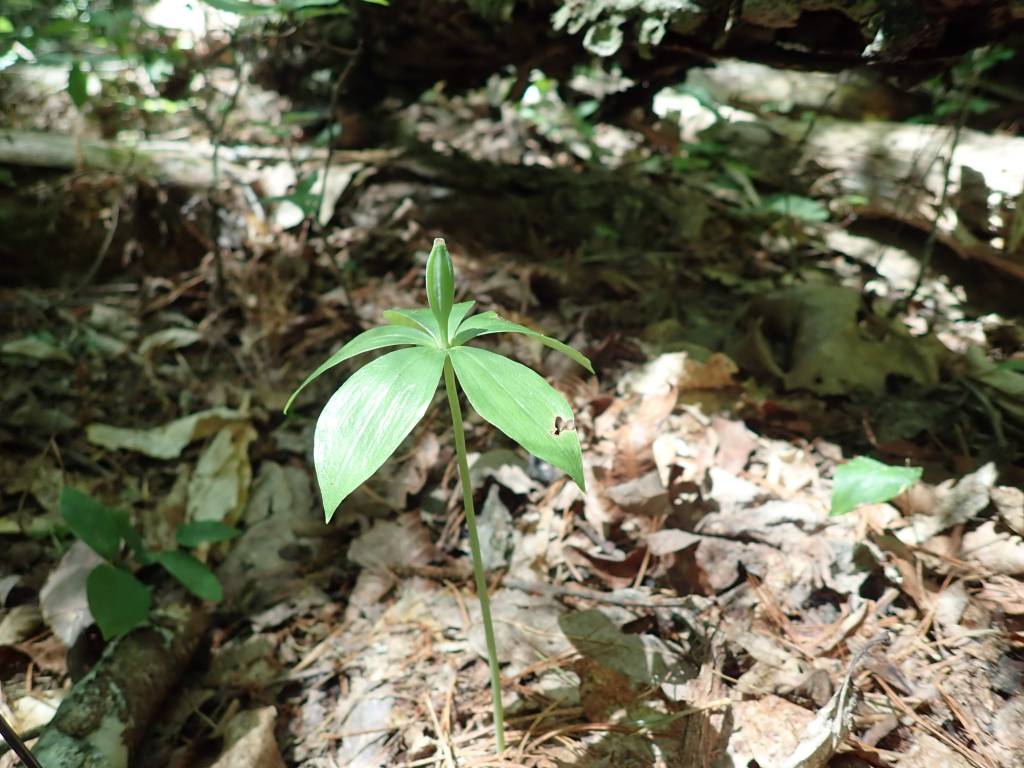
Fire and water at Mount Joy Pond
The story of this research project begins about 80 years ago, in a DuPont chemical plant in Waynesboro, Virginia. In the 1930s-1950s, the DuPont facility used mercury to produce rayon – a synthetic, silk-like fiber. Some of the mercury escaped from the plant and leaked into the South River – a tributary of the Shenandoah River. Mercury is a neurotoxin, and in the environment it can accumulate to dangerous levels in animals that are higher on the food chain, like fish. For many years, people living along the South River have been warned about the poor water quality and advised not to eat the fish.
In 2016, DuPont reached a $50 million USD settlement with the United States Department of Justice, the Department of the Interior, and the Commonwealth of Virginia to restore habitat for wildlife in the South River watershed, enhance water quality, and improve recreational areas. This settlement represented one of the largest environmental damage settlements in United States history.
Some of the DuPont settlement money was allocated to the Virginia Natural Heritage Program, a division of the Virginia Department of Conservation and Recreation that uses science-based conservation to protect Virginia’s plants and animals. Specifically, funds were provided to allow the Virginia Natural Heritage Program to protect and restore woodland habitat surrounding a unique wetland at the Mount Joy Pond Natural Area Preserve in Augusta County.
Briefly, Mount Joy Pond is a Shenandoah Valley Sinkhole community; that is, it is a groundwater-controlled wetland that floods intermittently when water percolates up through underlying carbonate rocks and then floods over the top of a clay lens perched in a layer of soil derived from the overlying sedimentary rocks. When this happens, the water becomes trapped, like water in a saucer. This unique situation creates wetland habitats which have persisted for the past 15,000 years and contain numerous rare and disjunct species, including the globally rare Virginia sneezeweed (Helenium virginicum). There are several dozen Shenandoah Sinkhole ponds, but only a handful of them are protected.
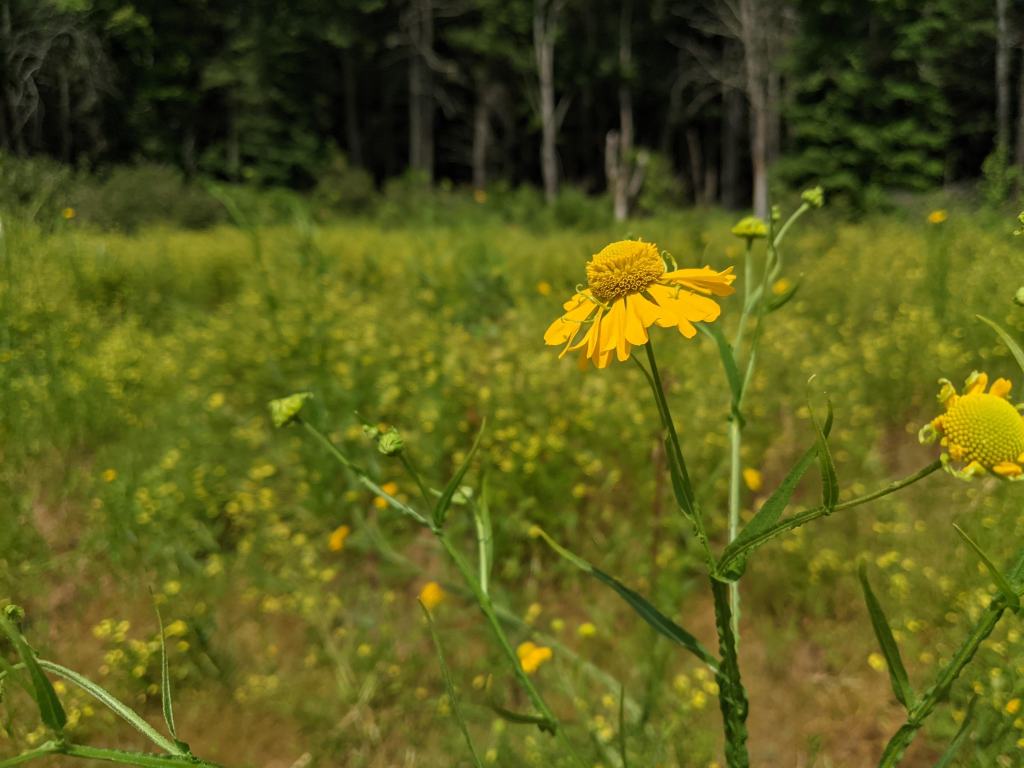
In the past, Mount Joy Pond filled with water every few years, but in recent decades it has filled up less and less often. To restore the wetland’s hydrology, the Virginia Natural Heritage Program set out to thin the surrounding forest and re-introduce fire to prevent fire intolerant trees, such as red maple, from regenerating. This may sound counterintuitive to some, but the logic is this:
- Each tree is like a drinking straw sucking water out of the ground and releasing it into the air via transpiration. If there are a lot of trees, the groundwater may stay too low to fill up the pond.
- Fire used to be much more common in the Shenandoah Valley. Prior to European colonization, Indigenous People burned the landscape and maintained much of it as savanna and open woodland – ecosystem types that have fewer trees than present day forests.
- By removing some trees and reintroducing a regular fire cycle, land managers at Mount Joy Pond Natural Area Preserve can restore an open woodland and raise the groundwater level, causing the pond to flood more often.
The Virginia Natural Heritage Program began to implement this restoration project in 2017, and the first thinning operations and burn were a success. In the years since, the groundwater level appears to have gone up, suggesting that the hydrological restoration plan is working.
Small whorled pogonia discovery
In the first spring after that first fire, a botanist was surveying the burned woods near the pond and found something unexpected – a small population of small whorled pogonia orchids, which had not been seen previously in the preserve despite extensive surveying by the Virginia Natural Heritage Program’s inventory team. Were the orchids there all along and nobody noticed them? Maybe. Or maybe the fire helped the orchid population emerge after years of suppression in the dense leaf litter in the shady understory.
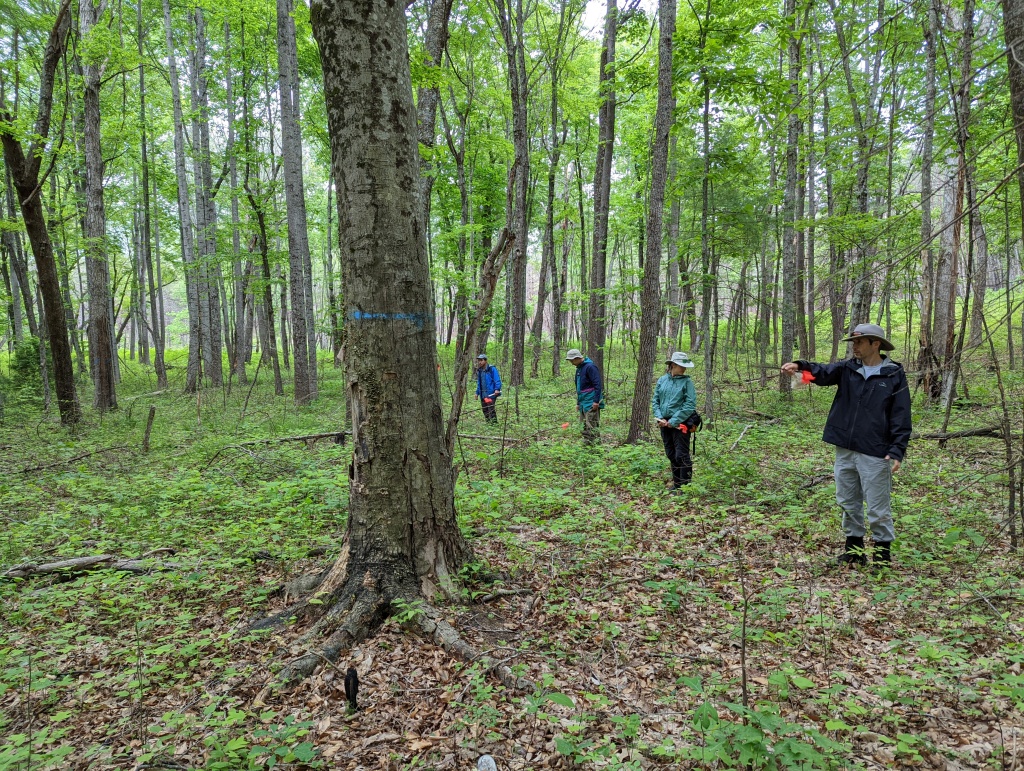
The story became more complicated later that summer when a more intensive search turned up a second population of small whorled pogonia orchids on the preserve – this one in an area that had not been burned.
The immediate consequence of discovering the new pogonia populations was that the United States Fish and Wildlife Service expressed concerns that future fire management might be detrimental to this threatened species. Nobody had studied how small whorled pogonia responds to fire, and there was a chance that burning could damage the population, even if it was good for the nearby pond’s hydrology. Of course, there was also a chance that not burning could damage the population. With fire, inaction is still an action.
To help settle the issue, the United States Fish and Wildlife Service agreed to sponsor a PhD student to study the small whorled pogonias at Mount Joy Pond and figure out how their population dynamics are impacted by prescribed fire.
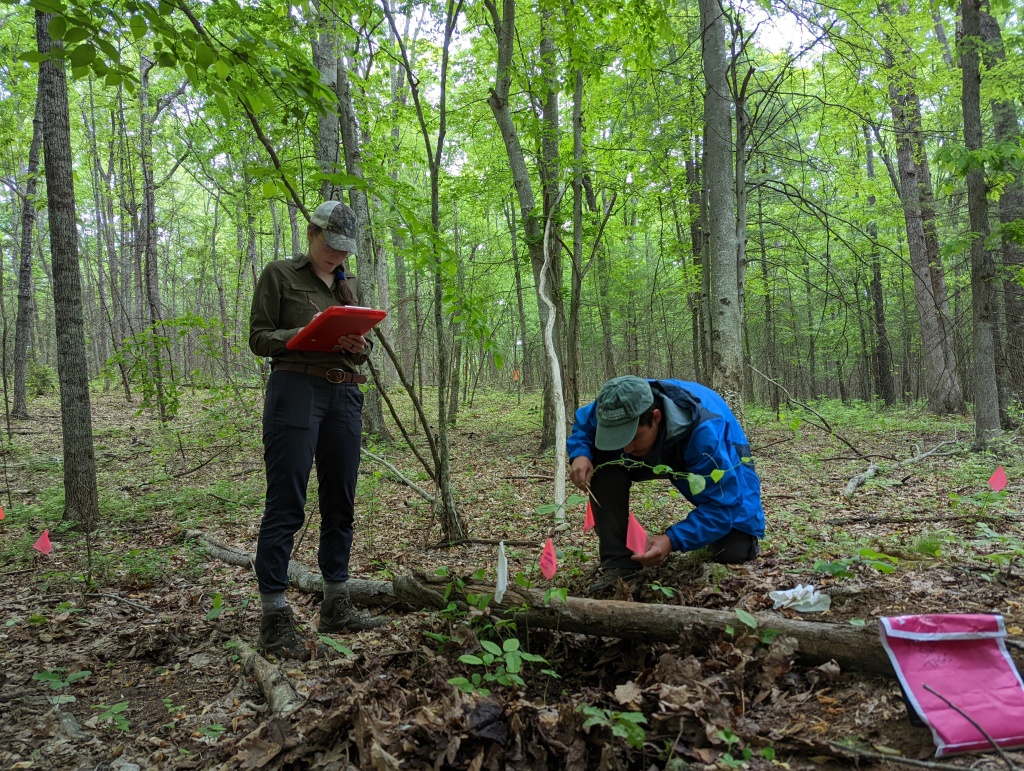
Effects of prescribed fire on small whorled pogonia orchids
The main goal of our ongoing research is to understand how prescribed fire impacts small whorled pogonias. To do this, we will map and monitor the two subpopulations and the woodland plant communities in which they live. Over the next two years, one of the two subpopulations will be burned during a winter or early spring prescribed fire, and we will continue monitoring to document changes in plant vigor, reproduction, and population size. We will pay special attention to the light environment, which seems to be important for small whorled pogonia reproduction, and to the diversity and composition of soil fungi, which are important for small whorled pogonia emergence. We will also conduct annual surveys of the entire reserve to search for additional populations.
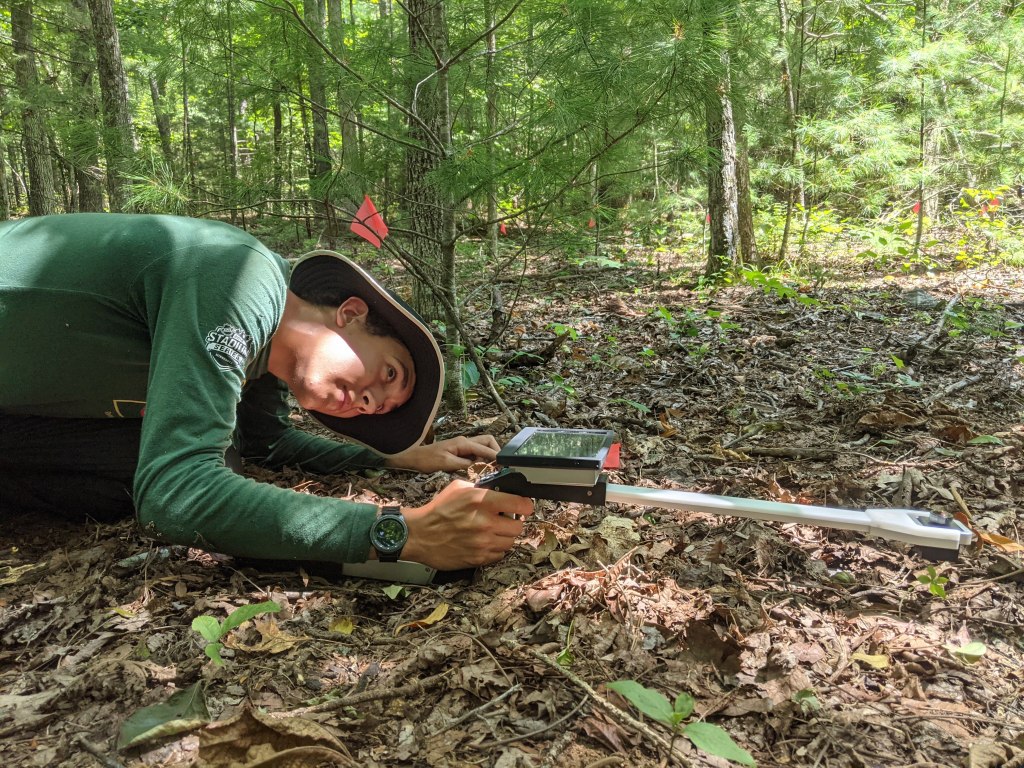
This project is just beginning. To date, we have monitored the two populations for two growing seasons (2021, 2022). There is still much work to be done. One of the next steps will be to produce an accurate map of each plant’s location, which will require centimeter-level precision using high-quality GPS equipment under a forest canopy.
We are currently seeking a PhD student to lead this research project starting in January 2023. A description of this opportunity is below. This project is an excellent opportunity for a student to develop expertise in ecological restoration and threatened species conservation from both a scientific perspective and an on-the-ground land management perspective.
Ultimately, the results of from this study will inform management of natural areas and small whorled pogonia restoration projects throughout the species’ wide range – from Ontario to Georgia.
